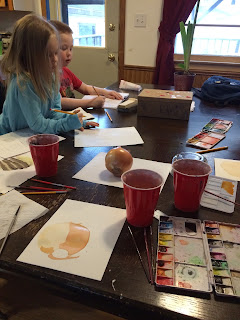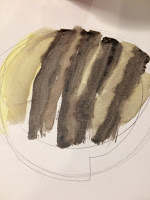Lift up your eyes on high, and behold who hath created these things, that bringeth out their host by number: he calleth them all by names by the greatness of his might, for that he is strong in power; not one faileth.
-Isaiah 40:26
Charlotte Mason has a reputation for being heavy on literature, and perhaps somewhat light on science, but I increasingly thing that this does not do justice to her methods. I do think, however, that her approach to science is going to be somewhat strange to modern parent-educators, as it's so very different from the model we grew up with in our public school education. But she herself gives no justification for the idea that you must choose a literary or a science education.
It is a wide programme founded on the educational rights of man; wide, but we may not say it is impossible nor may we pick and choose and educate him in this direction but not in that. We may not even make choice between science and the 'humanities.' Our part it seems to me is to give a child a vital hold upon as many as possible of those wide relationships proper to him. Shelley offers us the key to education when he speaks of "understanding that grows bright gazing on many truths."
-Charlotte Mason 6:157, emphasis added
In fact, Miss Mason frequently marries the humanities and to science: she leans heavily on the nature journal, blending art and writing with the training of the capacity for observation and questioning that stands at the heart of scientific inquiry. She's not the only one.
A century ago, drawing was taught as an essential skill for scientists, valued for communicating findings, but also for enhancing observations.
-Rediscovering the Forgotten Benefits of Drawing, emphasis added
 In our neck of the woods, January and February are typically too cold to be able to get outside consistently, or for any length of time: nature study outings are severely curtailed until spring. But we can use this season to train the skills that will enrich our experience when we can go back outside. We've been focusing on making good observations.
In our neck of the woods, January and February are typically too cold to be able to get outside consistently, or for any length of time: nature study outings are severely curtailed until spring. But we can use this season to train the skills that will enrich our experience when we can go back outside. We've been focusing on making good observations.Not too long before Christmas, I listened to a podcast (I've forgotten which one, unfortunately) that talked about how to teach brush drawing with watercolors. They suggested having the student pick a single color and draw -with a brush and not a pencil- a natural object that's been placed on a white piece of paper. The white paper simplifies the view of the subject, and clarifies the shadows. We did a painting like that, just before Christmas, of some flowers my husband had brought me.
Last week and this week, we've painted an onion. When I first called the kids to the table, I wouldn't let them touch their pencils and brushes until after we'd all spent a couple of minutes observing the onion and sharing our observations out loud. The group sharing is a technique we picked up from John Muir Laws, which he recommends for its synergistic effect: one observation inspires another, and when there are more observations bumping around in your brain because you can hear everyone else's as well as your own, then you find more inspiration and often make new observations yourself. This is particularly helpful for my child that struggles to see well.
 We did this same onion last week (these are our paintings from last week, Miss Kitty and Dragon on top, Hero and I at the bottom), and repeating with the same vegetable turned out to be really cool. There was obviously a lot the same about the model, since it was the same onion. But there was also a lot that was different: when I went to pick up the onion, some of the outer layers did like they sometimes do, and slipped off. So some parts are a different color this week, but the shape is the same, and the root ball at the bottom was the same.
We did this same onion last week (these are our paintings from last week, Miss Kitty and Dragon on top, Hero and I at the bottom), and repeating with the same vegetable turned out to be really cool. There was obviously a lot the same about the model, since it was the same onion. But there was also a lot that was different: when I went to pick up the onion, some of the outer layers did like they sometimes do, and slipped off. So some parts are a different color this week, but the shape is the same, and the root ball at the bottom was the same.Interestingly, the kids were also different: they brought new skills to this week's work because of things they learned last week. And that showed up in their drawings. Repetition of the exercise made it obvious.
 Both of the younger kids learned some important things about color mixing last week, which showed up in this week's drawings. Dragon learned about planning the amount of paint that he mixes up, and how it compares to the size of space he wants to color. You can see that Miss Kitty is more aware of the lines on the onion this week. She was also trying to draw out a circle - traced a bowl - to make a nicer circle; she hadn't be happy with her original one (the red line) from last week. But she was much happier this week.
Both of the younger kids learned some important things about color mixing last week, which showed up in this week's drawings. Dragon learned about planning the amount of paint that he mixes up, and how it compares to the size of space he wants to color. You can see that Miss Kitty is more aware of the lines on the onion this week. She was also trying to draw out a circle - traced a bowl - to make a nicer circle; she hadn't be happy with her original one (the red line) from last week. But she was much happier this week.She copied the circle idea from Dragon, who had grabbed a bowl to trace, then abandoned the idea after he struggled to get it to trace nicely. Dragon ended up asking me to hold my hands so that my fingers made a circle, which he traced, and then I suggested a couple of adjustments to help it match the onion a little better. He also asked for help with knowing what colors to mix: "Mom, you onion color is like perfect! Will you tell me how to do that?" So I showed him which colors I had used, and coached him on how to get light and dark tones of the same color. He did the mixing and the drawing and deciding on how to do things -- which turned out great. He was so pleased with the side-by-side comparison of his two onions: the improvements in his work are so obvious, and success just feels so good.
To me, there's so much more going on here than a couple of onion paintings. The kids are learning to see truly, to look closely. That's going to transfer when we go back out to the parks and work in our nature journals. That's going to transfer when they are looking through our new microscope. That's going to help them to do better when they are learning to cook (which is kitchen chemistry), and if they want to go on into "hard sciences" later on. Because seeing well does not come easily to Dragon, we've had several conversations this week about how a scientist needs to be able to observe things carefully, and pay attention to small details, in order to learn about what he's studying. And we've talked about how he'll be able to see his success at learning to observe by watching his art improve, because you must be able to see well to draw well. Between the success with his art, the new microscope, and the conversations, Dragon has for the first time announced what he wants to be when he grows up: a scientist. Sounds great to me. He's so curious about everything; he'd make a great scientist. And, in the mean time, there is some outstanding character growth going on here. Even if he changes his mind, these lessons in being able to see things deeply and truly, to be able to observe the world around him, these will be useful in a thousand different areas of his life.
Education is the Science of Relations'; that is, a child has natural relations with a vast number of things and thoughts: so we train him upon physical exercises, nature lore, handicrafts, science and art, and upon many living books, for we know that our business is not to teach him all about anything, but to help him to make valid as many as may be of––
"Those first-born affinities
That fit our new existence to existing things."
-Charlotte Mason 6:154





6 comments:
This is really neat. I like how you used the same subject (the onion) more than once. I can only imagine the same process when the weather turns nicer - paining trees as they flower and blossom.
ha.. I really like that. thoughtful approach....
Good observation skills and an eye for details are good things for scientists and artists. I love the combination of the two subjects - which are more closely related than we often think! Thanks for sharing this project on the Virtual Fridge!
I was reading just the other day how important the observation skills gain through art are for everyone to learn, not just artists. These are neat paintings they did. - Lori
What a fun and wonderful art/science project. I find we often combine art and science in our house; sometimes without even intending to. Thanks for sharing with us at the virtual Refrigerator. Pinned.
What a fantastic way to combine both science and art into one! I like how you initially let your children take their time observing the onion before having them put their project together.
Post a Comment